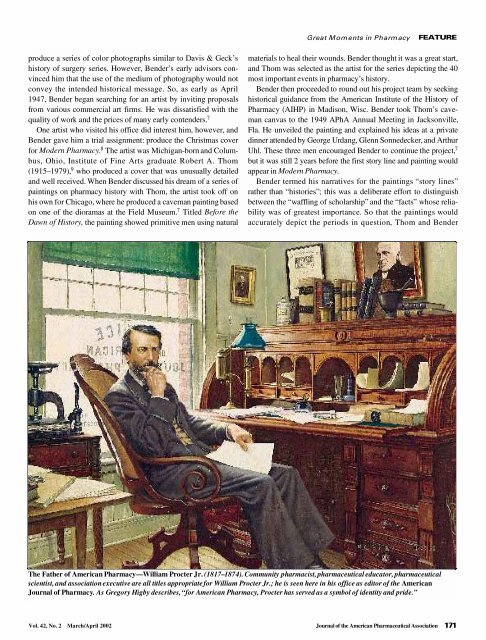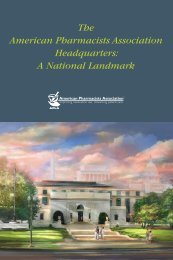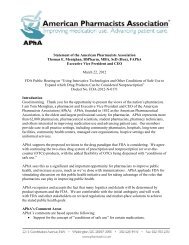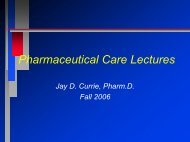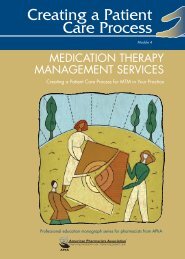Great Moments in Pharmacy - American Pharmacists Association
Great Moments in Pharmacy - American Pharmacists Association
Great Moments in Pharmacy - American Pharmacists Association
Create successful ePaper yourself
Turn your PDF publications into a flip-book with our unique Google optimized e-Paper software.
<strong>Great</strong> <strong>Moments</strong> <strong>in</strong> <strong>Pharmacy</strong>FEATUREproduce a series of color photographs similar to Davis & Geck’shistory of surgery series. However, Bender’s early advisors conv<strong>in</strong>cedhim that the use of the medium of photography would notconvey the <strong>in</strong>tended historical message. So, as early as April1947, Bender began search<strong>in</strong>g for an artist by <strong>in</strong>vit<strong>in</strong>g proposalsfrom various commercial art firms. He was dissatisfied with thequality of work and the prices of many early contenders. 7One artist who visited his office did <strong>in</strong>terest him, however, andBender gave him a trial assignment: produce the Christmas coverfor Modern <strong>Pharmacy</strong>. 8 The artist was Michigan-born and Columbus,Ohio, Institute of F<strong>in</strong>e Arts graduate Robert A. Thom(1915–1979), 9 who produced a cover that was unusually detailedand well received. When Bender discussed his dream of a series ofpa<strong>in</strong>t<strong>in</strong>gs on pharmacy history with Thom, the artist took off onhis own for Chicago, where he produced a caveman pa<strong>in</strong>t<strong>in</strong>g basedon one of the dioramas at the Field Museum. 7 Titled Before theDawn of History, the pa<strong>in</strong>t<strong>in</strong>g showed primitive men us<strong>in</strong>g naturalmaterials to heal their wounds. Bender thought it was a great start,and Thom was selected as the artist for the series depict<strong>in</strong>g the 40most important events <strong>in</strong> pharmacy’s history.Bender then proceeded to round out his project team by seek<strong>in</strong>ghistorical guidance from the <strong>American</strong> Institute of the History of<strong>Pharmacy</strong> (AIHP) <strong>in</strong> Madison, Wisc. Bender took Thom’s cavemancanvas to the 1949 APhA Annual Meet<strong>in</strong>g <strong>in</strong> Jacksonville,Fla. He unveiled the pa<strong>in</strong>t<strong>in</strong>g and expla<strong>in</strong>ed his ideas at a privated<strong>in</strong>ner attended by George Urdang, Glenn Sonnedecker, and ArthurUhl. These three men encouraged Bender to cont<strong>in</strong>ue the project, 7but it was still 2 years before the first story l<strong>in</strong>e and pa<strong>in</strong>t<strong>in</strong>g wouldappear <strong>in</strong> Modern <strong>Pharmacy</strong>.Bender termed his narratives for the pa<strong>in</strong>t<strong>in</strong>gs “story l<strong>in</strong>es”rather than “histories”; this was a deliberate effort to dist<strong>in</strong>guishbetween the “waffl<strong>in</strong>g of scholarship” and the “facts” whose reliabilitywas of greatest importance. So that the pa<strong>in</strong>t<strong>in</strong>gs wouldaccurately depict the periods <strong>in</strong> question, Thom and BenderThe Father of <strong>American</strong> <strong>Pharmacy</strong>—William Procter Jr. (1817–1874). Community pharmacist, pharmaceutical educator, pharmaceuticalscientist, and association executive are all titles appropriate for William Procter Jr.; he is seen here <strong>in</strong> his office as editor of the <strong>American</strong>Journal of <strong>Pharmacy</strong>. As Gregory Higby describes, “for <strong>American</strong> <strong>Pharmacy</strong>, Procter has served as a symbol of identity and pride.”Vol. 42, No. 2 March/April 2002 Journal of the <strong>American</strong> Pharmaceutical <strong>Association</strong> 171


